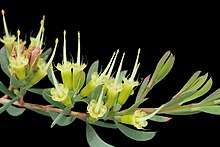Homoranthus lunatus
| Homoranthus lunatus | |
|---|---|
 | |
| Homoranthus lunatus in the ANBG | |
| Scientific classification | |
| Kingdom: | Plantae |
| Clade: | Angiosperms |
| Clade: | Eudicots |
| Clade: | Rosids |
| Order: | Myrtales |
| Family: | Myrtaceae |
| Genus: | Homoranthus |
| Species: | H. lunatus |
| Binomial name | |
| Homoranthus lunatus | |
 | |
| Occurrence data from AVH | |
Homoranthus lunatus is a plant in the myrtle family Myrtaceae and is endemic to a small area in northern New South Wales. It is a spreading shrub with curved leaves and small groups of up to six yellow flowers in leaf axils.[2]
Description
Flowers from July to November and fruits August to December.[3]
Taxonomy and naming
Homoranthus lunatus was first formally described in 1991 by Lyndley Craven and S.R.Jones and the description was published in Australian Systematic Botany.[4][5] The specific epithet (lunatus) is a Latin word meaning "shaped like a crescent moon".[6]
Distribution and habitat
Only found in a single population in Torrington district and locations in Boonoo Boonoo and Basket Swamp National Parks north east of Tenterfield New South Wales. Grows in heath on shallow sandy soils on and around granite outcrops.[3]
Conservation status
Considered vulnerable by Briggs and Leigh (1996). ROTAP code 2VCt. The plant should be considered rare.[3]
References
- ↑ "Homoranthus lunatus". World Checklist of Selected Plant Families (WCSP). Royal Botanic Gardens, Kew.
- ↑ Harden, Gwen J. "Homoranthus lunatus". Royal Botanic Garden Sydney. Retrieved 24 August 2018.
- 1 2 3 Copeland, Lachlan M.; Craven, Lyn A.; Bruhl, Jeremy J. (2011). "A taxonomic review of Homoranthus (Myrtaceae: Chamelaucieae)". Australian Systematic Botany. 24 (6): 351. doi:10.1071/SB11015.
- ↑ "Homoranthus lunatus". APNI. Retrieved 24 August 2018.
- ↑ Craven, Lyndley A.; Jones, S R. (1991). "A taxonomic review of Homoranthus and two new species of Darwinia (both Myrtaceae, Chamelaucieae)". Australian Systematic Botany. 4 (3): 513. doi:10.1071/SB9910513. Retrieved 19 August 2018.
- ↑ Brown, Roland Wilbur (1956). The Composition of Scientific Words. Washington, D.C.: Smithsonian Institution Press. p. 237.
External links